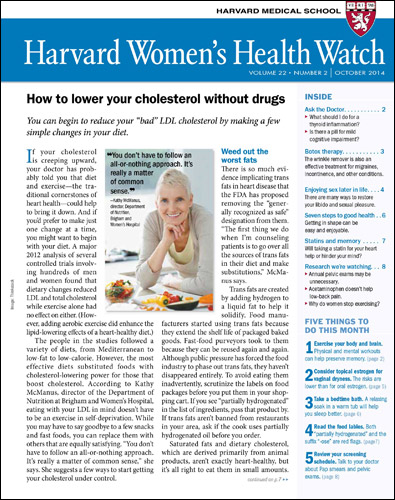Can a daily pill lighten heavy menstrual bleeding caused by fibroids?

Fibroids are generally benign (not cancerous) tumors that form within the tissues of the uterus. They are very common in reproductive-age women: studies report that up to 70% of white women and 80% of Black women may develop fibroids by age 50. And research suggests Black women are more likely to experience severe or very severe symptoms related to fibroids, such as heavy and sometimes prolonged monthly periods.
In some cases, women seek medical care due to menstrual bleeding so heavy that they develop anemia and require iron supplements or, much more rarely, blood transfusions. The FDA recently approved new medicine, taken as a pill, that may help some women reduce heavy bleeding caused by fibroids.
Surgery and injections help some women
Until recently, the treatment options for heavy bleeding due to fibroids were limited to surgical procedures or an injection of a medication called leuprolide, which is given monthly or every three months to help shrink fibroids and lighten bleeding. While these treatments are effective for some women, each has risks and disadvantages:
- Any surgical procedure comes with a risk of infection. Additionally, excess bleeding requiring transfusion, hysterectomy (removal of the uterus), injury to other pelvic or abdominal organs, and recurrence of the fibroids are possible. In some cases, fertility is affected as well.
- Regular injections of leuprolide have significant side effects, as this medication essentially puts women into medically induced menopause. Therefore, it is typically used only as a bridge to surgery.
What does research tell us about a new approach to fibroid-related heavy menstrual bleeding?
The new medicine approved by the FDA to treat heavy menstrual bleeding due to fibroids is Oriahnn. Taken twice daily as a pill, it combines two hormones (a form of estrogen called estradiol, plus norethindrone acetate) with a medication called elagolix. Elagolix helps inhibit a hormone that causes a woman's body to release estrogen and progesterone during her monthly menstrual cycle.
A recently published trial demonstrated that elagolix effectively decreases blood loss during menses, and causes high rates of amenorrhea (no bleeding at all). The trial was performed in conjunction with AbbVie, the company that produces and markets Oriahnn. It studied 433 women who had fibroids and heavy menstrual bleeding for 12 months per woman over a period of 2.5 years.
One strength of the study is that 67% of the women who participated were Black. Black women have higher rates of uterine fibroids, so their inclusion in this study is particularly important.
The study compared two groups of women for one year: one group received just elagolix, and the other received elagolix with estradiol and norethindrone acetate ("add-back therapy"). Because elagolix suppresses hormonal release of estrogen and progesterone, it may cause hot flashes, night sweats, and decreased bone mineral density (a marker indicating bone loss) that can predispose women to bone fractures. In theory, the add-back therapy might decrease the risk of hot flashes, night sweats, and bone loss.
For women taking elagolix with add-back therapy, the researchers found that by the end of 12 months:
- Nearly 90% of women had less blood loss during their period; compared with their blood loss before starting the medicine, these women experienced at least a 50% reduction in blood loss.
- 64% of women on elagolix with add-back therapy did not get a period at all.
- Among women who were anemic at the beginning of the study period, nearly 73% showed a statistically significant improvement in their blood count.
- The size of the uterus also decreased, although the size of the fibroids did not.
The most common side effects in both groups were hot flashes and headaches. Severe side effects were rare. However, compared with women taking only elagolix, women on elagolix with add-back therapy had fewer and less severe hot flashes and night sweats, and experienced much less loss of bone mineral density (although both groups demonstrated bone loss).
Based on a questionnaire given to both groups, women taking elagolix with add-back therapy reported a better quality of life.
Who might find this new option helpful?
This new FDA-approved medication could potentially be an excellent option for women who would like to avoid surgery and try medical management of their fibroids instead. The caveat is that the trial studied this drug for 12 months. The FDA has not approved its use for more than 24 months, so this may not be a lifelong solution for patients.
However, elagolix with add-back therapy could be an excellent option for women who are perimenopausal, will likely go through menopause in one to two years, and want to avoid a hysterectomy. It would also be an excellent option for women who are interested in conceiving in one to two years, and would like to decrease menstrual bleeding without resorting to surgery.
Women seeking long-lasting relief from heavy menstrual bleeding due to fibroids have long been told that their best option is a hysterectomy. This new data may have the potential to change that advice.
Disclaimer:
As a service to our readers, Harvard Health Publishing provides access to our library of archived content. Please note the date of last review or update on all articles.
No content on this site, regardless of date, should ever be used as a substitute for direct medical advice from your doctor or other qualified clinician.













